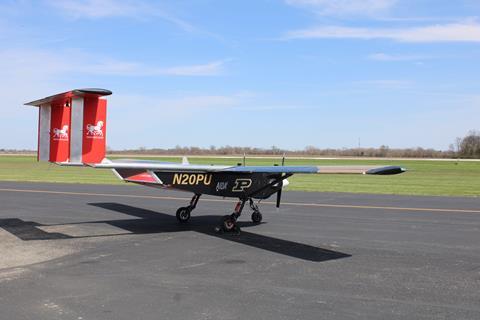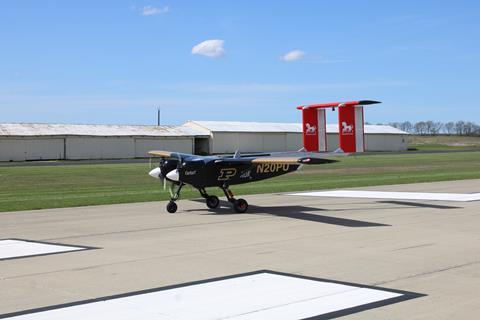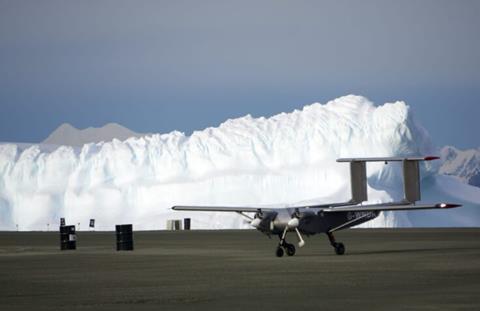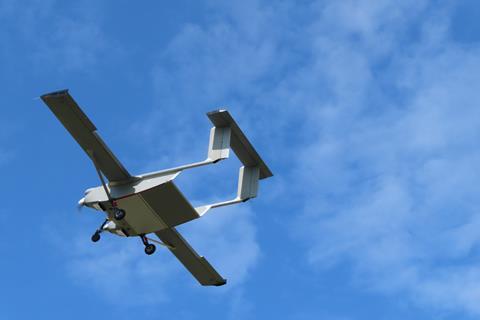Windracers, the UK-based manufacturer of autonomous cargo drones, is poised to introduce an upgraded version of its Ultra platform, which will gain a range and payload boost from uprated engines.
Meanwhile, the company has embarked on a five-year AI research partnership with Purdue University in Indiana seeking to enhance the autonomous flight capabilities of the aircraft and later this year will also start new operational trials in the north of the UK.

Under its upgrade plan, Windracers will raise by 80% the output from the Ultra’s engines, taking them to 45-50hp each, says co-founder and chairman Stephen Wright.
At present, the 627cc four-stroke engines are provided by US firm Briggs & Stratton, but the improved version will use powerplants from a different, although undisclosed, supplier.
Wright says the enhancement – currently in test – is part of the company’s strategy to “constantly upgrade” the platform. Once fielded, the new engines will offer a “significant increase in terms of capability”.
Windracers currently lists the twin-boom Ultra as being capable of carrying a 100kg (220lb) payload over distances of 540nm (1,000km). Other focus areas for improvement include “lowering costs, increasing reliability and extending airframe life”, Wright says.
Although in the longer term the company will consider building bigger aircraft, the continuous improvement philosophy means it has not yet reached that point.
“It’s a matter of debate within the team – my engineers are absolutely champing at the bit to build a bigger aircraft but I have restrained them historically… because the existing airframe is capable of carrying a lot more.”
In addition, Wright says it is not yet clear what size aircraft the market will demand in future: “It could be a payload of 200kg or 500kg. We don’t want to take that decision unless we take it on the basis of real data.”
Windracers manufactures the all-metal Ultra at an undisclosed site in southern England using parts fabricated in India. Having built an undisclosed total to date – it had completed 10 as of last autumn – it is progressively ramping up output to match increasing demand, with seven aircraft in final assembly in mid-April.
But to further increase the platform’s capabilities, the company in early April announced a partnership with Purdue University, setting up the Center on AI for Digital, Autonomous and Augmented Aviation, also known as AIDA3. One Ultra is already located in the USA, with a second to arrive in the coming weeks.

Those assets will be named Earhart and Armstrong after storied aviators with links to the facility – Amelia Earhart was a visiting faculty member of the univestity and Apollo 11 astronaut Neil Armstrong an alumnus.
Detailing the collaboration, Windracers says the research to be conducted will “ensure self-flying aircraft can be operated efficiently and at scale”.
Multiple applications for AI and machine learning will be investigated, it says, but one of the key activities will be tuning the aircraft’s systems to allow multiple aircraft to be monitored by a single controller.
“AI is not a universal panacea – but there are very specific areas of our activities where it can make an important difference,” says Wright.
“The primary task is to give us the capability for one operator to fly 10, 20 or 30 aircraft at once.”
While such a goal is technically feasible at present “the challenge is that you need to demonstrate that to the regulator in a safe way, and that’s what the research is focused on”.
Obtaining that clearance would enable Windracers to drive down the Ultra’s operating cost “so we can compete in a much wider part of the logistics market”.
Windracers has previously tested the Ultra from Kirkwall airport’s Sustainable Aviation Test Environment (SATE) facility, operating postal and cargo services in the Orkney Isles.
A second test phase is due to launch later this year, again operating from Kirkwall to multiple locations in northern Scotland.

It follows a successful period of operation on behalf of the British Antarctic Survey from January to March this year during which the Ultra flew thousands of kilometres in the polar region carrying a variety of scientific payloads.
In all, five of six intended missions were completed, says Wright, with no issues seen with the platform itself.
“I think it was really successful and off the back of that we have been approached by other research organisations to provide a similar service for their work in that part of the world.
“It’s a challenging environment to operate in. Fortunately, we didn’t have any problems – to be frank, it turned out to be easier than flying in the Orkneys.”
Although others in the space are happy to simply manufacture the vehicles and control systems, Windracers also intends to operate the aircraft itself. “We will be an air cargo provider and rent space on our aircraft,” says Wright.
“We don’t want to be in all parts of the chain but the object to at the moment we are obliged to in order to really drive progress.”
Originally designed as a rugged aircraft to serve the humanitarian aid sector, Windracers is hopeful of securing additional contracts in the space.
Featuring a 10m (32ft)-wingspan and all-metal construction, the Ultra has a twin-boom configuration with a high T-tail to allow easy access to its 700-litre cargo compartment.
































